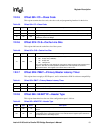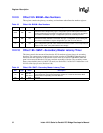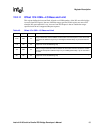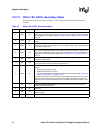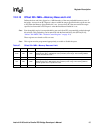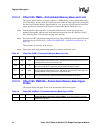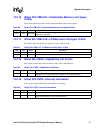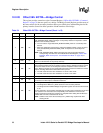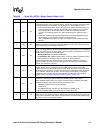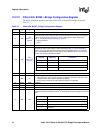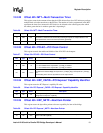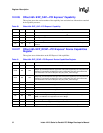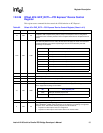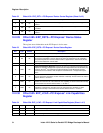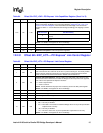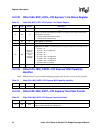
Intel
®
41210 Serial to Parallel PCI Bridge Developer’s Manual 89
Register Description
5RW 0b
Master Abort Mode (MAM): This bit controls the bridge’s behavior when a master-abort (or
unsupported request) occurs on either interface. This bit does not affect the behavior when
the bridge forwards a UR completion from PCI Express* to master-abort on PCI-X.
0 = Do not report master-aborts. When a UR response is received from PCI Express* for
non-posted transactions, and when the secondary side is operating in conventional
PCI mode, the device returns FFFF FFFFh on reads and completes I/O writes
normally. For posted transactions, the data is discarded and no additional action is
taken.
1 = Report UR completions by signaling a target-abort on the secondary/peer interface
when operating in conventional PCI mode. The device returns
ERR_NONFATAL/ERR_FATAL messages for posted transactions initiated from PCI
Express*.
4RW 0b
VGA 16-bit Decode: This bit enables the bridge to provide 16-bit decoding of VGA I/O
address precluding the decoding of VGA alias addresses every 1 KB. This bit requires the
VGA enable bit (bit 3 of this register) to be set to 1.
3RW 0b
VGA Enable (VGAE): This bit modifies the response to VGA-compatible addresses. When
set to 1, the bridge forwards the following transactions from PCI Express*-to-PCI regardless
of the value of the I/O base and limit registers. The transactions are qualified by the memory
enable and I/O enable in the command register.
Memory addresses: 000A 0000h–000B FFFFh
I/O addresses: 3B0h–3BBh and 3C0h–3DFh. For the I/O addresses, bits[63:16] of the
address must be 0, and bits[15:10] of the address are ignored (aliased).
The same holds true from secondary accesses to the primary interface in reverse for
memory accesses and also for I/O when the upstream I/O enable bit is set in the BINIT
register, from secondary to primary.
2RW 0b
ISA Enable (IE): This bit modifies the response by the bridge to ISA I/O addresses. This
function applies only to I/O addresses that are enabled by the I/O base and I/O limit
registers and are in the first 64 KB of PCI I/O space. When this bit is set, the bridge blocks
all forwarding from primary to secondary of I/O transactions addressing the last 768 bytes in
each 1 KB block (offsets 100h to 3FFh). This bit has the reverse effect on I/O transfers
originating on the secondary bus when the upstream I/O enable bit is set in the BINIT
Register (“Offset FCh: BINIT—Bridge Initialization Register” on page 104).
1RW 0b
SERR# Enable (SE): This bit controls the forwarding of secondary interface SERR#
assertions on the primary interface. When set, the bridge sends a PCI Express*
ERR_NONFATAL/ERR_FATAL cycle (based on Advanced Error capability’s PCI SERR
detected severity bit) when all of the following conditions are true:
• SERR# is asserted on the secondary interface.
• This bit is set.
• The SERR# detected mask bit in the Advanced Error capability is set.
• ERR_NONFATAL/ERR_FATAL messages are enabled to be sent.
0RW 0b
Parity Error Response Enable (PERE): This bit controls the response to address and data
parity errors on the secondary interface. When the bit is cleared, the bridge must ignore any
parity errors that it detects and continue normal operation. The bridge must generate parity
even when parity error reporting is disabled.
Table 54. Offset 3Eh: BCTRL—Bridge Control (Sheet 2 of 2)
Bits Type Reset Description



